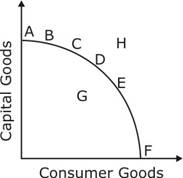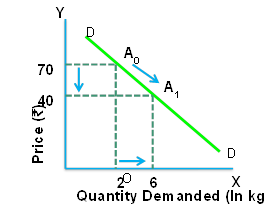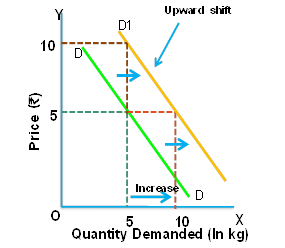Economics : 2017 : CBSE : [All India] : Set I
To Access the full content, Please Purchase
-
Q1
Any statement about demand for a good is considered complete only when the following is/are mentioned in it (Choose the correct alternative) :
(a) Price of the good
(b) Quantity of the good
(c) Period of time
(d) All of the above
Marks:1View AnswerAnswer:
Correct Answer is option (d) All of the above
Explanation: Demand refers to the quantity of a commodity which a consumer is willing to buy at a given price in a given period of time.
-
Q2
Demand for a good is termed inelastic through the expenditure approach when if (Choose the correct alternative).
(a) Price of the good falls, expenditure on it rises
(b) Price of the good falls, expenditure on it fails
(c) Price of the good falls, expenditure on it remains unchanged
(d) Price of the good rises, expenditure on it falls
Marks:1View AnswerAnswer:
Correct Answer is option (b) Price of the good falls, expenditure on it fails
Explanation: When, as a result of decrease in price of a good, the total expenditure made on the good falls or when as a result of increase in price, the total expenditure made on the good increases, we say that price elasticity of demand is less than unity elastic or inelastic.
-
Q3
Define indifference curve.
Marks:1View AnswerAnswer:
An indifference curve is the locus of all points representing those combinations for which a consumer is indifferent. It shows different combinations of two goods which provide equal level of satisfaction to the consumer.
-
Q4
A seller cannot influence the market price under (Choose the correct alternative)
(a) Perfect competition
(b) Monopoly
(c) Monopolistic competition
(d) All of the above
Marks:1View AnswerAnswer:
Correct Answer is option (a) Perfect competition
Explanation: A perfectly competitive market has been defined as one where an individual firm is unable to influence the price at which the product is sold in the market. The firms of the perfectly competitive market produce homogenous goods and they are the price takers. The entry and exit of firms in this form of market is not restricted and there are a large number of buys and sellers in this form of market.
-
Q5
State any one feature of monopolistic competition.
Marks:1View AnswerAnswer:
In monopolistic competition markets consumers have clearly defined preferences and sellers attempt to differentiate their products from those of their competitors; the goods and services produced in this market structure are differentiated but are close substitutes of one another.
-
Q6
Give the meaning and characteristics of production possibility frontier.
Marks:3View AnswerAnswer:
Production possibility frontier or curve may be defined as a curve which represents various possible combinations of two commodities that can be produced with fuller utilisation of given resources in an economy. It can be explained with the help of the following diagram:

In the given diagram curve AF represents the production possibility frontier between consumer goods and capital goods. Points A, B, C, D, E and F, represent various combinations that an economy can produce from given scarce resources.
Production Possibility Frontier has following three basic characteristics: -
(1) It slopes downwards: Production Possibility Frontier is based on the assumption of fuller and efficient utilisation of resources. It represents the maximum production level that can be achieved. Hence the production of one commodity can be increased only by transforming the resources from another commodity i.e. by reducing the production of another commodity.
(2) It is concave to the origin: It is based on the concept of increasing marginal opportunity cost. When the resources are withdrawn from one commodity in order to increase the production of another commodity the opportunity cost increases because of differences in the efficiency of resources in different productive activities.
(3) It represents the production frontier for the economy: It is based on fuller and efficient utilisation of resources due to which it represents maximum production level that can be achieved. Hence any combination lying outside the production possibility curve cannot be achieved from the given amount of resources and level of technology.
-
Q7
Explain the problem of “how to produce”
Marks:3View AnswerAnswer:
How to produce may be defined as the problem of choice of technique of production. Since resources are scarce, the choice of technique of production should be such that it undertakes production with minimum wastage and cost. Such a production technique is said to be efficient.
The two main techniques of production are labour intensive technique or capital intensive technique of production. The former involves more use of labour than capital in the production process, while the capital intensive technique of production involves more use of capital than labour. It is efficient to use that resource intensively for production which is available abundantly in a country.
-
Q8
Distinguish between ‘increase in demand’ and ‘increase in quantity demanded’ of a good.
Marks:3View AnswerAnswer:
Increase in quantity demanded
Increase in Demand
Demand increases due to fall in the price of the commodity. It is also known as expansion of demand.
Demand increases due to change in any other factor except price.
There is no change in other factors affecting demand.
There can be change in any one or all factors affecting demand e.g. increase in income of consumer, increase in price of substitute goods, decrease in price of complementary goods, improvement in taste etc.
Leads to a downward movement along the same demand curve

Leads to upward or rightward shift of the demand curve.

-
Q9
Explain the meaning of ‘Budget set’ and ‘Budget line’.
Marks:3View AnswerAnswer:
The budget set is a collection of all bundles of commodities that a consumer can purchase at market price with his money income. A consumer has fixed income and he has to allocate his income to such bundle of commodities where he can get the maximum satisfaction.
The budget line is the locus of points that show such combinations of two goods that the consumer can buy with his given income and at given prices. It is downward sloping because when consumer purchase more of one good he must reduce the purchase of the other good with his given income and at given prices.
-
Q10
Explain with the help of a numerical example, the meaning of Diminishing marginal rate of substitution.
Marks:4View AnswerAnswer:
Marginal Rate of Substitution (MRS) is the rate at which the consumer can substitute one good for another without changing the level of satisfaction. It indicates the slope of an indifference curve. Diminishing Marginal Rate of Substitution implies that the consumer will be willing to give up less and less quantities of Good Y for every additional quantity of Good X. This is because of the law of diminishing marginal utility.
For example, in the table given below bundle A, B, C and D lie on the same indifference curve. Good X lies on the X axis and good Y lies on the Y-axis. As the consumer increases the amount of ice-cream consumed, the additional utility from ice-cream goes on decreasing. Due to this the consumer is willing to give up less and less quantity of chocolate for each additional unit of ice-cream. Thus the marginal rate of substitution of X for Y is diminishing.
Bundles of Chocolate and Ice-cream
Ice-cream (X)
Chocolate (Y)
MRS = ∆Y/∆X
A
1
10
-
B
2
7
3
C
3
5
2
D
4
4
1



